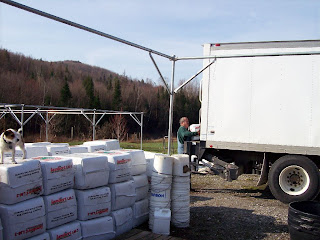
Monday, April 19, 2010
The sun is trying hard to get through the clouds this morning as a 3 mph wind chases water drops from all the flowers. Not much of a weekend for being outside but a good one for catching up on paperwork. I'm heading out in a minute to drop off my truck alternator for a rebuild at the Wild Auto Electric Shop in Barre. The shop has been there for a long time and if you need an alternator or generator rebuilt, this is the only place to go. My truck has 118,000 miles on it and I guess it's time to be better prepared for things to fall apart.
 Saturday night, friends Harold and Leila Cross from Morrisville arrived for dinner. We are all crazy about flowers and both operate nurseries. Prior to their arrival, Gail was heading out to pick some daffodils for the table but I suggested she forget the decorative gesture and wait for Harold to bring her some. I decided I knew Harold better than Gail did as she headed out anyway to fill a vase for the table.
Saturday night, friends Harold and Leila Cross from Morrisville arrived for dinner. We are all crazy about flowers and both operate nurseries. Prior to their arrival, Gail was heading out to pick some daffodils for the table but I suggested she forget the decorative gesture and wait for Harold to bring her some. I decided I knew Harold better than Gail did as she headed out anyway to fill a vase for the table. Along came Harold and Leila, right on time, and as I expected, Harold had a large bouquet of mixed daffodils. He has been collecting different varieties for a couple-three years now and he has a very nice collection started. Gail laughed when she accepted the gift and of course shared the story of my earlier recommendation. More laughs!
Along came Harold and Leila, right on time, and as I expected, Harold had a large bouquet of mixed daffodils. He has been collecting different varieties for a couple-three years now and he has a very nice collection started. Gail laughed when she accepted the gift and of course shared the story of my earlier recommendation. More laughs! Forever people ask about the difference between daffodils and narcissus and a simple read for Narcissus on Wikipedia tells us that "daffodils" is the common name that we most often follow. I don't have a clue how many varieties are now available but as Harold's collection attests, there is plenty of color available to gardeners in their spring gardens.
Forever people ask about the difference between daffodils and narcissus and a simple read for Narcissus on Wikipedia tells us that "daffodils" is the common name that we most often follow. I don't have a clue how many varieties are now available but as Harold's collection attests, there is plenty of color available to gardeners in their spring gardens. Every plant has a plant society and daffodils are well represented by the American Daffodil Society. If you are interested in this bulb plant, take a look. Planting and growing instructions, bulb sources and a listserv are just some of the benefits of a membership.
Every plant has a plant society and daffodils are well represented by the American Daffodil Society. If you are interested in this bulb plant, take a look. Planting and growing instructions, bulb sources and a listserv are just some of the benefits of a membership. I haven't mentally recorded the names of any of these daffodils although Harold remembers them very well. I don't even know how many varieties are recorded but I have seen hundreds available in different catalogs. If you're interested in a nice spring display like Harold and Leila have, do your research now and be sure to have your orders placed by late August for fall planting. Neither Harold and Leila nor Vermont Flower Farm sell the bulbs but we all have an interest in seeing bright smiling flower faces each April. Bet you will too! Here are a few more pictures. Enjoy!
I haven't mentally recorded the names of any of these daffodils although Harold remembers them very well. I don't even know how many varieties are recorded but I have seen hundreds available in different catalogs. If you're interested in a nice spring display like Harold and Leila have, do your research now and be sure to have your orders placed by late August for fall planting. Neither Harold and Leila nor Vermont Flower Farm sell the bulbs but we all have an interest in seeing bright smiling flower faces each April. Bet you will too! Here are a few more pictures. Enjoy!

Writing from the mountain above Peacham Pond where the weatherman says 40 degrees and windy is about the best we'll do today.
George Africa
The Vermont Gardener
Vermont Flower Farm: Taking web and phone orders for late May shipping
On Facebook at Vermont Flower Farm & Gardens
On Twitter as vtflowerfarm












































